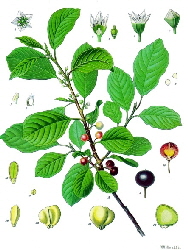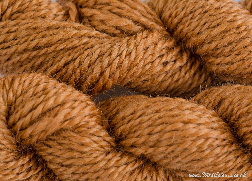Biology of Alder Buckthorn
 Alder Buckthorn is a large, slow-growing shrub that reaches up to 5 metres in height. It is called Alder Buckthorn because of its close association with alders but, despite the name, it is thornless. This shrub is native of Europe and it is easily grown, it can be made into hedges and it coppices well. Alder Buckthorn is a good bee plant and a main food plant for the larvae of the yellow brimstone butterfly. It produces small red berries in the spring that become black when ripe. The fresh bark and the unripe fruit are, however, toxic. Alder Buckthorn is a large, slow-growing shrub that reaches up to 5 metres in height. It is called Alder Buckthorn because of its close association with alders but, despite the name, it is thornless. This shrub is native of Europe and it is easily grown, it can be made into hedges and it coppices well. Alder Buckthorn is a good bee plant and a main food plant for the larvae of the yellow brimstone butterfly. It produces small red berries in the spring that become black when ripe. The fresh bark and the unripe fruit are, however, toxic.
Note: The famous Persian berries come from another species of Buckthorn, Rhamnus saxatilis.
Dyeing with Alder Buckthorn bark
This is a useful dye, as it can be used without a mordant. You will get mustard yellows on wool by simmering, and brick or cinnamon red by fermentation.
You will get richer colours with dried alder buckthorn bark than you will with fresh bark.
a) Fermentation or alkaline extraction method with buckthorn bark

This method has been used since the Iron Age and it is very useful because it does not require the use of mordants which were not widely available in the past. Fermentation dyeing works well with barks of plants rich in tannin (for example oak, maple, willow and birch). The longer you ferment the better, 3 to 4 weeks is a good time, but some people ferment for 3 to 10 years. You need to keep the container closed to avoid contamination by moulds, the lid also helps to contain the odour which can be quite strong.
An advantage of this method is that little water is needed and no source of heat other than the sun. Disadvantages include the smell and that it is time consuming.
You will need:
- 100 gm buckthorn bark
- 100 gm un-mordanted wool
- soda ash
- water
- pH paper
- bucket with lid
Note: don’t use an airtight container, as the fermentation can increase pressure inside the container and cause it to burst.
Measure about 100 ml of very hot water in a measuring container and add 1 teaspoon of soda ash. Top up to the 1 litre mark with cold water. Check the pH which should be about 10 or 11. Transfer the water to the bucket and add the 100 grams of buckthorn bark. Stir well and put the lid on. Stir the contents everyday, and check the pH. As the bark ferments, the contents of the bucket become acidic (i.e. the pH lowers), so you will need to add more soda ash to keep the pH around 10. Add more soda ash about one teaspoon at a time and remember to dissolve first in a little hot water as described above. Replace the lid every time. Keep stirring and checking the pH for 3 to 4 weeks, keeping the pH to about 9 for the first 3 weeks.
On the last week let the pH go down to about pH 7. At the end of the 4 weeks, place a sieve over another container and strain the bark through the sieve keeping the liquid. Pour more water through the sieve, ‘washing the bark’. When there is enough water in the container add the wool and leave for 2 weeks, stirring daily and making sure the wool is under the liquid. Dry in the shade.
There are several variations of this method, with some dyers preferring to add the fibre at the same time as the bark, others add the fibre half way through the fermentation process.
For more details of this method see Heritage of Colour by Jenny Dean.
b) Simmering method with Alder Buckthorn bark
- 100 grams of mordanted or unmordanted wool
- 50 grams of alder buckthorn bark
Pour boiling water over the bark and leave overnight. Next day simmer gently for an hour. Strain the bark and add the fibre. You can use the bark again or dry it for future use.
Back to other reds including
1. Madder
2. Brazilwood
3. Cochineal
4. Safflower
5. St John’s Wort, Ladies’ Bedstraw & Dyers’ Woodruff
Top of page
|